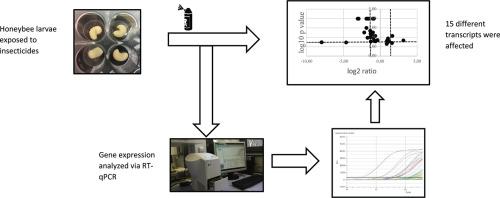当前位置:
X-MOL 学术
›
Pestic. Biochem. Phys.
›
论文详情
Our official English website, www.x-mol.net, welcomes your feedback! (Note: you will need to create a separate account there.)
Effects of selected insecticidal substances on mRNA transcriptome in larvae of Apis mellifera
Pesticide Biochemistry and Physiology ( IF 4.7 ) Pub Date : 2020-11-01 , DOI: 10.1016/j.pestbp.2020.104703 Arne Kablau , Jakob H. Eckert , Jens Pistorius , Soroush Sharbati , Ralf Einspanier
Pesticide Biochemistry and Physiology ( IF 4.7 ) Pub Date : 2020-11-01 , DOI: 10.1016/j.pestbp.2020.104703 Arne Kablau , Jakob H. Eckert , Jens Pistorius , Soroush Sharbati , Ralf Einspanier

|
For the last decade, scientists have reported a loss of honeybee colonies. Multiple factors like parasites, pathogens and pesticides are dealt as possible drivers of honeybee losses. In particular, insecticides are considered as a major factor of pollinator poisoning. We applied sublethal concentrations of four insecticidal substances to honeybee larval food and analyzed the effects on transcriptome. The aim was to identify candidate genes indicating early negative impacts after application of insecticidal substances. Honeybee larvae were kept in-vitro under hive conditions (34-35 °C) and fed with dimethoate, fenoxycarb, chlorantraniliprole and flupyradifurone in sublethal concentrations between day 3-6 after grafting. Larvae at day 4, 6 and 8 were sampled and their transcriptome analyzed. By use of a RT-qPCR array differences in gene expression of selected gene families (immune system, development detoxification) were measured. Targets mainly involved in development, energy metabolism and the immune system were significantly affected by the insecticidal substances tested, selectively inducing genes of the detoxification system, immune response and nutritional stress.
中文翻译:

选定杀虫物质对蜜蜂幼虫mRNA转录组的影响
在过去的十年里,科学家们报告了蜜蜂群的丧失。寄生虫、病原体和杀虫剂等多种因素被视为蜜蜂损失的可能驱动因素。特别是,杀虫剂被认为是授粉媒介中毒的主要因素。我们将四种杀虫物质的亚致死浓度应用于蜜蜂幼虫食物,并分析了对转录组的影响。目的是确定表明施用杀虫物质后早期负面影响的候选基因。蜜蜂幼虫在蜂箱条件 (34-35 °C) 下体外饲养,并在嫁接后第 3-6 天之间以亚致死浓度喂食乐果、苯氧威、氯虫苯甲酰胺和氟吡呋酮。对第 4、6 和 8 天的幼虫进行取样并分析它们的转录组。通过使用 RT-qPCR 阵列,测量了所选基因家族(免疫系统、发育解毒)的基因表达差异。主要参与发育、能量代谢和免疫系统的靶标受所测试杀虫物质的显着影响,选择性诱导解毒系统基因、免疫反应和营养应激。
更新日期:2020-11-01
中文翻译:

选定杀虫物质对蜜蜂幼虫mRNA转录组的影响
在过去的十年里,科学家们报告了蜜蜂群的丧失。寄生虫、病原体和杀虫剂等多种因素被视为蜜蜂损失的可能驱动因素。特别是,杀虫剂被认为是授粉媒介中毒的主要因素。我们将四种杀虫物质的亚致死浓度应用于蜜蜂幼虫食物,并分析了对转录组的影响。目的是确定表明施用杀虫物质后早期负面影响的候选基因。蜜蜂幼虫在蜂箱条件 (34-35 °C) 下体外饲养,并在嫁接后第 3-6 天之间以亚致死浓度喂食乐果、苯氧威、氯虫苯甲酰胺和氟吡呋酮。对第 4、6 和 8 天的幼虫进行取样并分析它们的转录组。通过使用 RT-qPCR 阵列,测量了所选基因家族(免疫系统、发育解毒)的基因表达差异。主要参与发育、能量代谢和免疫系统的靶标受所测试杀虫物质的显着影响,选择性诱导解毒系统基因、免疫反应和营养应激。



























 京公网安备 11010802027423号
京公网安备 11010802027423号